The Sega Saturn Sure Is A Weird Console But At Least Emulation Is Finally "Solved"
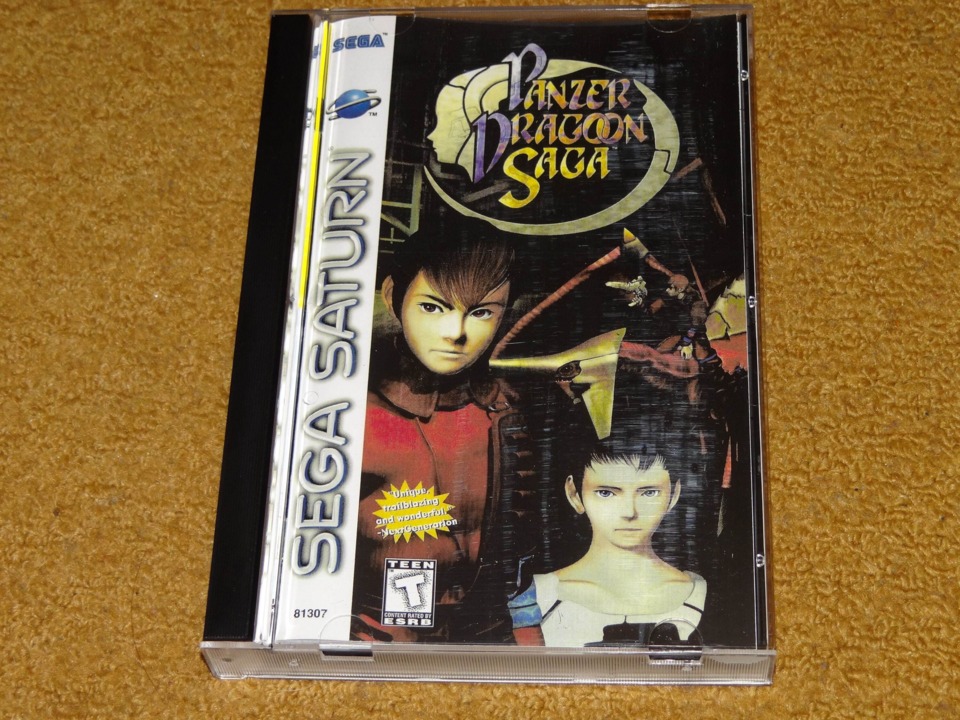
For as long as I have been alive and playing games, the Sega Saturn has had a "reputation." During my early years, I accepted that reputation as fact and brandished it as a "failed" console that only weirdos on specific game boards or Usenet servers would discuss. It was a narrative I maintained into my adulthood that only changed thanks to the written and podcast works of Borgmaster and Jeffrud. In the past few years, I have since come to understand it to be, yes, a commercial failure, but one also largely victimized by System Wars or Console Wars hyperbole, and maybe the most of any video game console ever made. It's not THAT BAD and has an artistic and aesthetical identity severely lacking with the current slate of video game consoles and ecosystems. And if you think the Staurn should be brandished as a "failure," and that's all that needs to be said, I have to pose one fact to you. Foremost, and this next point is going to hurt, and I'm not sorry if I am the one who needs to break this news to you. But Japan and MOST of Europe did not give a SHIT about the Nintendo 64, and the Saturn outsold the N64 by a decent margin in Japan. The reputation of the N64 as a legendary platform that kept things competitive with Sony and was responsible for sunsetting Sega as a console figurehead is genuine fake news. "Saturnday" being a disaster and "299" standing as the single most significant E3 moment ever aside, the notion that the Sega Saturn was dead on arrival is primarily an American narrative that has since been grafted onto the console's whole reputation worldwide. As Borgmaster covered on his blog series, after the first year the PS1 and Saturn were in the midst of their "war," it was still not a foregone conclusion that the Playstation would win, which speaks to the quality of software carrying the Saturn as Sega's management continually kneecapped its viability.
What gets lost in the mix is a catalog of video games that pushed the technical envelope and a fairly dedicated team of programmers and designers that genuinely do not get the credit they deserve. The topic of this particular blog, Panzer Dragoon Saga, is a console JRPG with an almost fully 3D game world with full voice acting a whole three years before Squaresoft attempted as much with Final Fantasy X. And the Saturn itself is both at the core of why many of those games were able to achieve such impressive technical highs as well as the primary reason why those achievements got so little attention. What impresses me, jokes at the expense of Nights into Dreams aside, is that people could do outstanding 3D work on the Sega Saturn in the first place. If your frame of reference for good rail shooters is Rez or Star Fox, you owe it to yourself to at least play Panzer Dragoon II Zwei. Zwei utilizing fully 3D characters, enemies, particle effects, and worlds at 30 FPS with alternate paths and high-fidelity audio is astounding. The intricate animations of enemies and bosses are a sight to see if the game is a complete black void in your gaming knowledge. Similarly, Virtua Fight and Virtua Fighter 2 maintained a stable cadre of fighting game fans until Tekken 3 finally ripped that away from the Saturn.
Unfortunately, those historical landmarks went underreported even in the emulation and historical gaming crowd, thanks to the Sega Saturn being a peculiar thing. Originally envisioned as a console that would handle 2D sprites, mainly 2D sprites based on arcade hardware, Sega never planned for it to take on Sony's best shot. That's partly because Sony's best shot was still a big "known unknown" in the industry. However, midway through development, the advent of 3D graphics was starting to emerge, and rather than discard the progress they had made with their 2D processor, the Saturn development team decided to put two in-house video display processors into a single console. One would be better for handling 2D graphics and sprites, the other for 3D polygons. However, making these processors work together took a lot of work. I want you to imagine your computer or laptop that you are using right now having TWO GPUs, and it's not an SLI setup. Instead, each GPU works to accomplish entirely different things, and you have to enable one to do streaming or web surfing and the other for multimedia work or gaming. Likewise, at the end of the day, the Saturn really just wanted to spit out arcade-quality sprites, and Sega wasn't exactly clear about that. More alarming, Sega wasn't precisely forthcoming to third-party developers about strategies on how to use the Saturn's hardware to its fullest potential. Panzer Dragoon Saga, a fully 3D RPG experience on hardware that does not want to cooperate with such an endeavor, is nothing short of a miracle. On top of that, Panzer Dragoon Saga has about 90 minutes of full-motion video, which the Saturn was okay at handling but could have been better, especially if we are concerned about framerate. And yet, Sega was pitiful about getting out dev kits and creating developer networks that shared tips and advice like Sony did with the PS1. So, their lessons and accomplishments often, as is the case with Saga, became lamentable one-offs. Seriously, look at this real-time morphing they crammed into this game! How was Sega NOT sharing this knowledge with everyone that still cared about its hardware?
Those parallel processors are one of the MANY reasons why the Sega Saturn was, for ages, the Loch Ness Monster in the emulation community. Needing to translate not one or two processors but EIGHT, because I did not talk about the Saturn having multiple CPUs to support its dual GPU setup, has led to many emulator projects getting abandoned after showing initial promise. Yabause, one of the better options four or five years ago, was an acronym for "Yet Another Broken And Unfinished Saturn Emulator," and it only reached about a 70% compatibility rate before becoming abandoned. Another thorn in the emulation community's side is that the Saturn uses quadrilaterals rather than triangles as polygons. If you are an art or design major, that creative decision alone is an immediate "deal breaker." The sprites and 3D polygons warp and wobble much like they do on the N64 and PS1, but differently ever so slightly. Also, capturing how games like Panzer Dragoon Saga would oscillate between the Saturn's competing processors to complete different computational tasks takes a lot of work to translate on modern hardware. Finally, Panzer Dragoon Saga is sometimes one of the games many Saturn emulators outright avoid because it spans four discs, and disc swapping is a pain for emulators to handle.
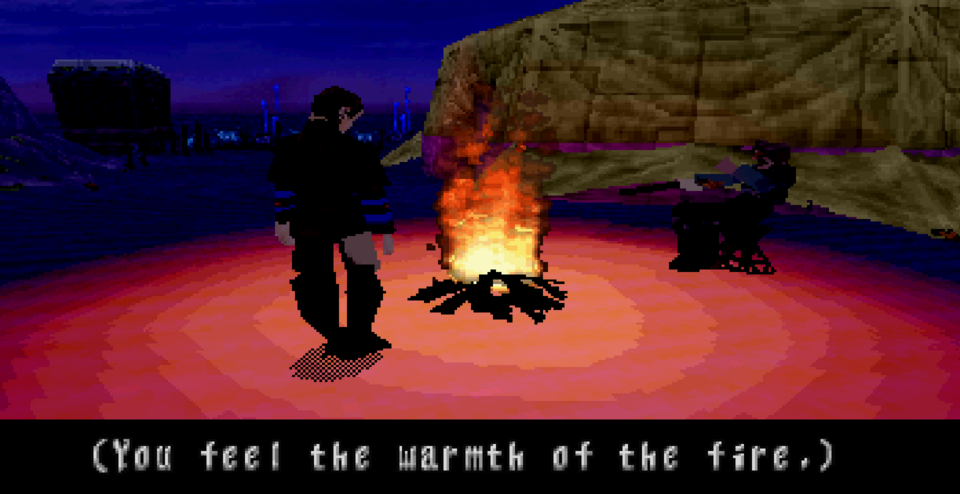
Nonetheless, Mednafen, an open-source, multi-system emulator, has reached almost complete compatibility with the Sega Saturn. It is followed by SSF, a closed-source Windows-only emulator, and Kronos, a fork of Yabause, as decent alternatives. Solved are the weird framerate inconsistencies with older emulators and, in Saga's case, disc swapping, with the advent of Mednafen. All that remains now is the thorny issue of Sega Titan Video-oriented hardware and software, which is only partially "solved," but that's a topic for another blog. Discussing emulation is usually a thorny issue for some. Still, in the case of Panzer Dragoon Saga, it is a necessity, given playing the game as God intended will cost you over $2,000. Trust me, I scanned eBay for over two months, and the cheapest I saw Panzer Dragoon Saga go for was $575, which only had the discs and no game box. It remains one of the most coveted video games in the retro gaming collection hobby, and that was the case even before prices on old games exploded. I love you all, but I don't love you THAT MUCH. Finally, Fandom's Panzer Dragoon Wiki even has a guide on troubleshooting common issues with the most popular emulators with the Saturn Panzer Dragoon games. So, I will hazard a guess and say this topic isn't a big deal with Panzer Dragoon Saga fans.
The Panzer Dragoon Franchise Sure Is Confusing
To understand Panzer Dragoon Saga properly, you must understand the studio that created it: Team Andromeda. Team Andromeda was an internal branch of Sega, or Sega Consumer Research and Development Dept. #1 (i.e., Sega CS1), to be exact. Team Andromeda ballooned to slightly over forty people when development on Panzer Dragoon Saga peaked, a considerable number in the 1990s. As a comparison, the Virtua Cop port to the Sega Saturn had a team of five people. Sega and Team Andromeda preferred small and nimble groups, but they were signing up for a genre and type of game that would not allow that. Worse, Andromeda split its stretched team into two groups, with one half working on Panzer Dragoon II Zwei and the other on Saga. As if the stress levels couldn't get worse, Saga's prime directive from the CEO of Sega was to create "an RPG to outsell Final Fantasy and help the Saturn compete against the PlayStation." Talk about pressure. Still, Team Andromeda had a strong leader who was initially up for the challenge, and that man was Yukio Futatsugi. When Sega signaled to all of its internal teams that the Saturn was a real thing and it was taking pitches, Futatsugi emerged as someone willing to fill the corporate identified void for a shooting game after his pitch for a racing game lost out to a different Sega internal team offering to port Rad Mobile to the Saturn. However, being an art student with an appreciation for film, Futatsugi elected not to make a traditional shooting game. Instead, he pulled ideas from Space Harrier and decided for Panzer Dragoon that the shooting would take place on a dragon because he thought the articulation of the dragon would be a better showcase of the Saturn's power. And that's how Panzer Dragoon and Panzer Dragoon II Zwei came to be.
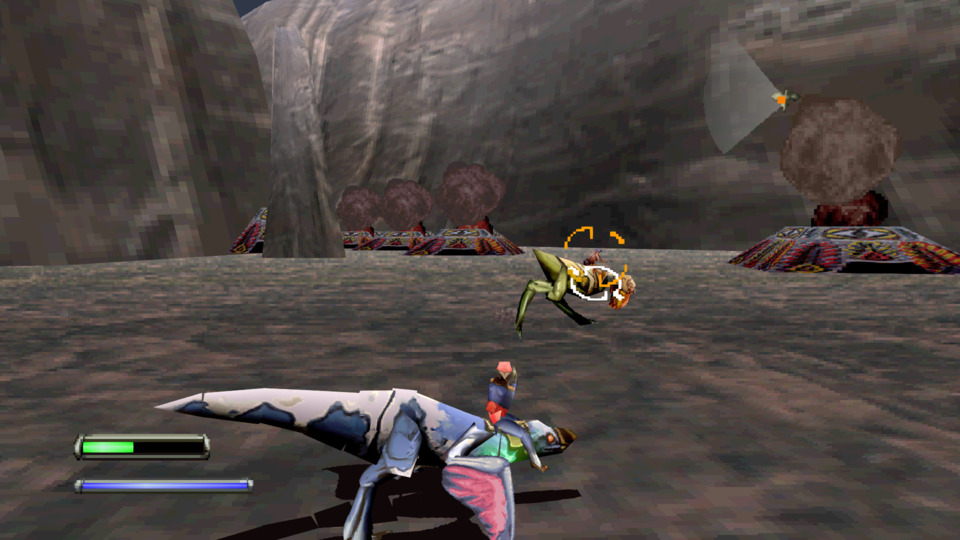
Panzer Dragoon was a decent enough success for the Saturn that Sega's corporate leaders saw Futatsugi as a possible figurehead for the company along with the likes of Yu Suzuki and Yuji Naka, and as a result, afforded Futatsugi and Team Andromeda more creative freedom than other divisions of Sega. Called "avant-garde and anti-establishment," Team Andromeda was at first a moderate-sized team of strong-willed artists not accustomed to needing to moderate ideas and concepts that were sometimes impractical or beholden to the laws of diminishing returns. Nonetheless, seeing their rival, Sony, successfully foster internal and third-party partners like Naughty Dog, Squaresoft, and Psygnosis, Sega's leaders encouraged Team Andromeda to think outside the box and aim creatively for the stars practically for their entire existence. Sega put twenty-plus art grads in the same room and expected everyone to get along, and even when things got messy with Panzer Dragoon Saga's development, they refused to get hands-on with its management. As such, when the team grew, Futatsugi and Sega got worse at managing personality clashes and conflicts during Saga's production. Saga's development quickly became a mess, with the game being delayed several times and its budget ballooning monthly and yearly. By the time it neared completion, the Dreamcast was already a talking point within Sega, which further gutted its team's spirits and led to calls from within its ranks for Sega's corporate administration to pull the plug. And here's an exciting part of the story. The game likely would have been canceled had it been in the hands of any other console manufacturer. However, Sega's CEO and Bernie Stolar were so impressed by the technical demos of Panzer Dragoon Saga they saw that they refused to cancel the game. Is Stolar somewhat to blame for the game's minimal software run? Sure, but he's also part of why we can play the game in the first place. This point leads us to the unfortunate fate of Team Andromeda. After Panzer Dragoon Saga underperformed and failed to turn the fortunes of the Saturn, Team Andromeda was subsumed with the Sega PC team to form Smilebit. If that name sounds familiar, you might know it better by its current name, Sega Sports R&D (i.e., the Mario & Sonic at the Olympic Games team).
One of two possible reactions greets you when you mention "Panzer Dragoon Saga" on the internet. The first is from the Panzer Dragoon fandom, which maintains a pseudo-fanatical tenor with the game and its legacy. When you check Wikipedia's painfully long "List of video games considered the best" page, you'll notice that it is on there and most likely was added thanks to rigorous wrangling from the small subset of people who even got a chance to play it when it came out. The Panzer Dragoon fanbase is a small subset of people, but they are ravenous and are one of those sub-communities in the gaming hobby that always find their way to new discussions about their favored games. The other reputation is that this game is costly on the re-sale market, and there's a reason for that. Only 20,000 copies of the game were sold in North America, and only approximately 1,000 copies graced the entire continent of Europe. It did not help that its several delays placed it further on the fringes of the Saturn's lifespan. Hilariously, and there are two versions of this story, but one of the reasons why Panzer Dragoon Saga was delayed was to avoid having it released against Grandia. For one version of this story, it is claimed that Team Andromeda lacked confidence in their project, and they viewed Grandia as a threat. The other version holds management moved Saga's release away from Grandia because getting GameArts to side with Sega hardware was considered a "get," and management wanted to do them a solid. Nonetheless, the fact that it has good art, novel gameplay, or experienced a tortured production cycle falls to the wayside of the previous two reputations.
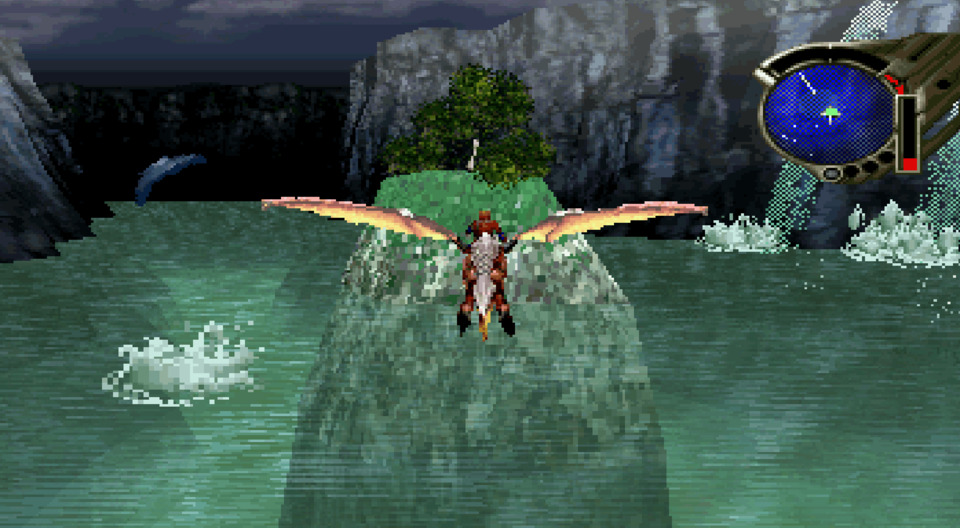
But what is Panzer Dragoon Saga? At its heart, Panzer Dragoon Saga attempts to marry a rail shooter with a JRPG with a design and programming team that had never made an RPG. It was also Team Andromeda's attempt to use the Saturn's 3D processor to set new gold standards of what fully 3D game worlds could look like. It was ALSO Sega's pet project meant to nab bragging rights from Sony and Squaresoft in light of Final Fantasy VII, while the two were at the zenith of their cultural and financial power. It might sound unbelievable, but the latter is the only actual "failure" of the game, as the end product is one of the most visually stunning and technically impressive games from the fifth generation of game consoles. And while we have seen teams that are not familiar with RPG conventions and then try their hands at repeating them in a new title to disastrous results ad infinitum, that's not the case here, either. The movement-based combat and 3D environmental exploration all lead to an experience that is welcoming to those who want a JRPG without the usual massive time investment. It is also an incredible experience for those who love getting into the nitty-gritty of the genre for hours upon end.
Panzer Dragoon Saga's Development Was Painful And Deeply Problematic
The center of why Panzer Dragoon Saga's development was so deeply problematic was the hardware it was attempting to work with, but also to blame was Team Andromeda constantly wanting to one-up what they were seeing around them. Though the game's initial target was to make a Saturn JRPG experience that matched and exceeded Final Fantasy VI on the SNES, as that was Team Andromeda's initial frame of reference, upon the release of Final Fantasy VII, they kept moving their personal goal posts to push the Saturn's hardware to its limits. As mentioned, the game features a staggering amount of voice acting, mainly in Japanese with English subtitles, and even in the era, the voice acting exceeded all standards for the medium in 1998. Likewise, Team Andromeda didn't take the easy route of programming its voice acting that close contemporaries like Metal Gear Solid took. It features facial animations and lip flap that matches the characters' words. Speaking of the game's audio design, we must discuss its musical score. The score is done entirely through pulse-code modulation and uses ZERO prerecorded music, an ABSURD creative decision to make from top to bottom. The result is that every track slaps and has a sharpness you usually don't experience in games of this era. The game's score is a mix of South American, African, Celtic, classical, and new age, and while that might sound confusing on paper, the final product is digital bliss to your ears. Admittedly, Zwei did the same in opting against using prerecorded music, but Zwei is a rail shooter where everything progresses at a break-neck speed. In an RPG with a semi-open world, doing so limits the number of usable loops for every track, hence why most cap out below the four to five-minute mark. Nonetheless, one exception is the game's final song that plays when you reach the credits, and this song, though done in the game's in-universe language of Panzerese, is the single best vocal piece to grace a fifth-generation console. It's better than the song at the end of Chrono Cross, and it is better than "Eyes on Me" and "Melodies of Life."
The artistic elitism that led to Team Andromeda becoming a premier branch of CS1 was a blessing and a curse. There's no doubting the talent and creative ambition that define everything the studio touched. Still, they committed so many unforced errors that caused Saga's development to progress painfully. First, the team used no graphics libraries and programmed everything from scratch, a decision that is simply unconscionable today. On top of that, Yukio Futatsugi convinced Sega's leadership to open up the checkbook to buy dozens of full commercial licenses of Softimage to assist in making an RPG with fully 3D worlds and real-time morphing effects. When Tomohiro Kondo, the producer of Zwei, admitted they were not the right person to design an RPG combat system, Team Andromeda convinced Sega leadership to let them "borrow" Akihiko Mukaiyama, the lead game and combat designer behind Sakura Wars/Sakura Taisen on the Saturn. Mukaiyama and Futatsugi have both admitted that because Team Andromeda felt the need to make things from scratch and not emulate Enix or Square's menu-based combat systems, merging the shooting gameplay of the Panzer Dragoon series into an RPG took a year of design and programming time alone.
More absurd is how the programming and design team shaded Panzer Dragoon Saga's 3D worlds. Panzer Dragoon Saga is one of the purest examples of a 3D game that utilizes Gouraud shading instead of flat or Phong shading techniques. Flat shading is the easiest, but upon inputting lighting sources creates an incredibly blocky look. During the early days of 3D graphics, there emerged two dominant styles that addressed that issue: Gouraud and Phong shading. Gouraud provides a standard vector to each vertex of a 3D object's surface and then calculates the light source and the vector for each vertex. In more complicated terms, it interpolates an in-engined light source for each vertex or interpolates colors across polygons to make the shading appear smooth. If you enjoy the 3D graphics of mid to late-era N64 games, you are more familiar with Phong shading. Phong shading is a significant improvement over Gouraud shading as it interpolates normal vectors across rasterized polygons, and for reflections, that normal vector is interpolated and normalized at each pixel. That might be too technical for most of you, but understand that Gouraud shading struggles with light sources that occur in the middle of large polygons, and when that light source attempts to spread across a surface, it extends unnaturally. If a programming and design team is stuck using Gouraud shading techniques, the only workaround is to increase the number of vertices in the object to make surfaces smoother. That last point is the kicker with Panzer Dragoon Saga's art team. They did not care about those diminishing returns for reasons that have never been made apparent. They kept banging their head on this very well-known shortcoming and did not stop. As costs ratcheted up, they kept at it, manually adding more pixel depth to everything in the game they could touch.
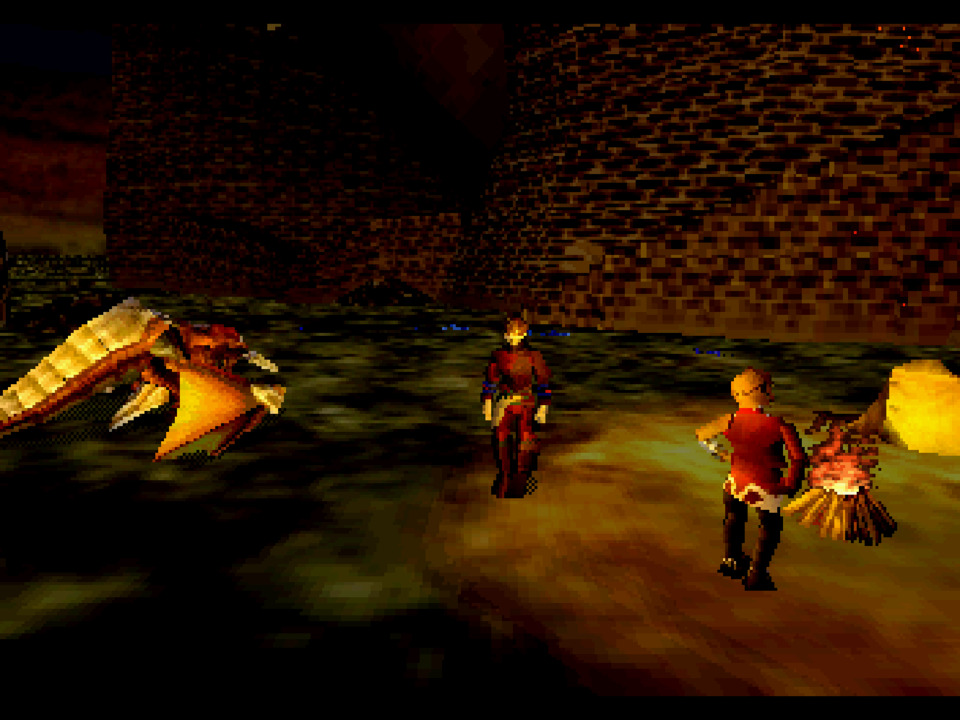
Now that we all appreciate that Team Andromeda was willing to go to technical extremes to make Panzer Dragoon Saga, we need to discuss the human cost of its development. Right off the bat, two people died during the production of Panzer Dragoon Saga. The first death was a motorcycle accident that Futatsugi still attributes to stress and lack of sleep stemming from overwork. The second death was a suicide directly attributed to the tensions and infighting experienced in Team Andromeda. Futatsugi has admitted that the deaths deeply impacted him and, to push the game across the finish line took on a "bad cop" persona or role in pushing out the factionalism in Team Andromeda but, in doing so, domineered over those who joined the team for its reputation of valuing creative freedom. Futatsugi has apologized for some of his authoritarian management during Saga's development but has primarily characterized it as "a necessary evil," which I must add some, but not all of his former co-workers, have accepted. With that in mind, it shouldn't be too surprising for you to know that when pressed on which game he considers his favorite project, Futatsugi has continually responded with "Phantom Dust." In a retrospective about the game, The Ringer put it best in saying that Panzer Dragoon Saga was "a game about a world in ruins, produced by a disintegrating development team haunted by heartbreak at a company in decline."
The First Disc Of Panzer Dragoon Saga Matches The Heights Of Final Fantasy VII's First Disc
But what about the game itself? As mentioned earlier, Panzer Dragoon Saga is a weird marriage between a rail shooter and an RPG, and the fact that this marriage works is a miracle. The fully 3D environments certainly have draw distance issues. Still, the first five to six levels provide sandboxes where you freely fly around with verticality (i.e., it uses an x, y, and z-axis). At the same time, random encounters pop off at rates dependent on the environment. While piloting the dragon, you can pick up hidden goodies and often solve an environment-based puzzle at least once per level. Even when out of combat, you can use your dragon's laser attack to take down enemy towers or defensive embattlements or blow up storage units to find new equipment. You accomplish this by pulling up the reticle, scanning for targets, and then unleashing a volley of lasers from the dragon, though the number of volleys you have depends on your level. The exploration bits in between the starts and ends of chapters essentially play precisely like the mainline Panzer Dragoon games and, as a result, are immensely more entertaining and more interactive than the standard overworld-based interludes found in anything Enix Corp. or Squaresoft made contemporaneously to Saga. And the levels are smartly designed, with the development team turning off random encounters entirely in levels they know you want to fly around and explore and do your usual Panzer Dragoon stuff.
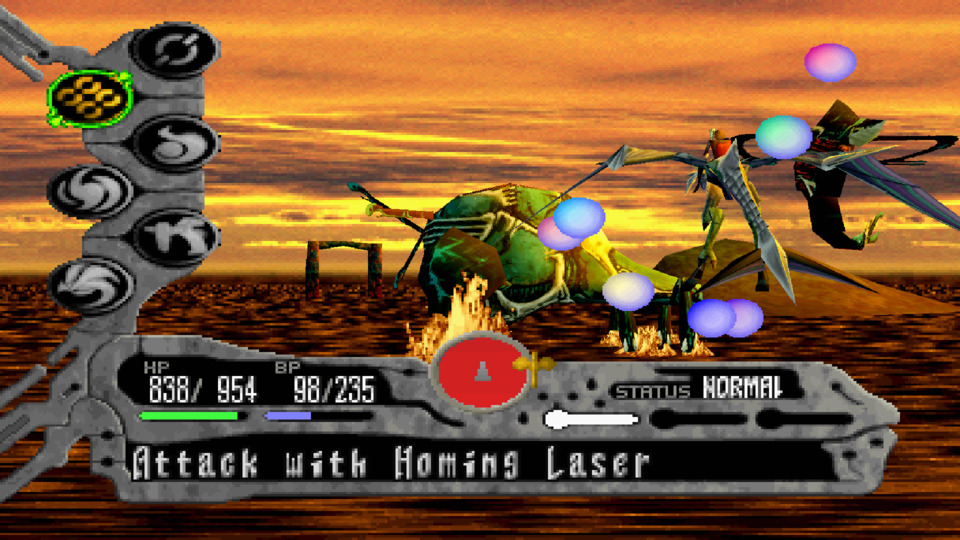
The battle system follows the trend of Team Andromeda wanting to follow in the footsteps of the then titans of the JRPG landscape but with a twist or two. This next point will sound odd, but in Panzer Dragoon Saga, you only have three types of attacks. You can use a gun with the main character, Edge, your dragon's laser, and unique magical abilities. Specific enemy types will sometimes be immune to one of these attacks, prompting you to experiment with different strategies. When you unlock the dragon morphing mechanic, you will often enter a new level or dungeon, immediately tell what the gimmick is with its encounters, and then, on the fly, swap your dragon to a different alignment. The screen where you do this is incredible. However, the combat is where Team Andromeda's self-poaching of the director of Sakura Wars draws the most extraordinary dividends. In tapping a strategy/tactics designer to rehaul its combat system, Panzer Dragoon Saga utilizes a pseudo-real-time combat system where you rotate and fly around enemy groups and bosses to find weak points and vulnerabilities to deal extra or critical damage as you would with a back attack in Sakura Wars or Final Fantasy Tactics. It's an advantageous system and never ceases to make you feel good when you finally "get" the gimmick to any encounters, especially bosses. Yet, this combat system is still primarily turn-based, as your attacks depend on a bar that mimics the ATB meter in the Final Fantasy franchise. Nonetheless, you can still rotate around what you are attacking and use a compass with cardinal coordinates to move Edge and his dragon companion into red areas to deal double damage or green areas to avoid KO-dealing super moves.
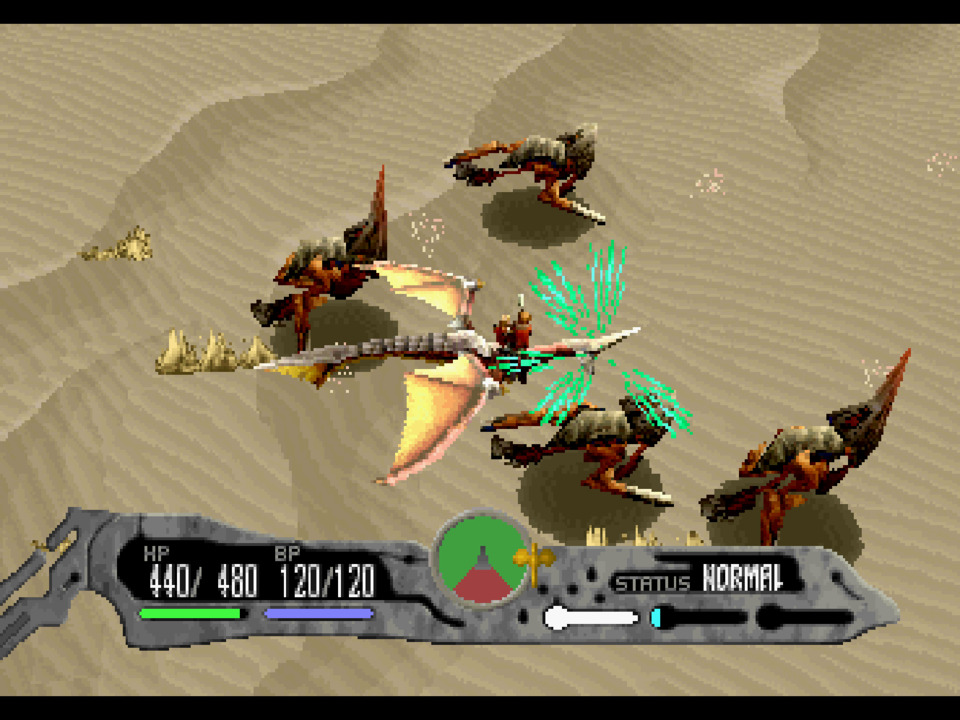
Having the player dynamically manage their placement and position while thinking about their menu-based attacks leads to an experience that feels like a real-time combat system, even if it isn't. Each battle's a sweeping affair that's both pleasing to the eyes and an impressive technical display of what the Saturn was capable of. Also, Panzer Dragoon Saga essentially takes the sometimes dull and sluggish non-boss combat of JRPGs of this era and turns them into rhythm games wherein the specific encounter you are up against can be wasted in under twenty seconds, as long as you understand where you need to position yourself and which attacks work best against those enemies. A common issue with Final Fantasy VII and Dragon Quest VII is when you know you need to grind and are conscious that the battles you are in will take two to three minutes to complete, even though they are foregone conclusions. With Panzer Dragoon Saga, you use the radial indicator to immediately identify danger zones and safe areas to place your avatar. There's also a scoring/grading mechanic, and it rewards you for determining how to finish battles quickly and with as little taken damage as possible. Thanks to that, the battles become races with you trying to one-up yourself in beating them faster than last time. Speed is the name of the game with every Panzer Dragoon title, and the fact that Team Andromeda captured that in a genre that is notorious for bogging things down with menus and player-based analysis paralysis makes it worth playing even if you have grievances against the excesses of the JRPG genre. Likewise, every enemy encounter has unique animations that provide context clues on when you should rotate in and out of different zones to complete battles even faster, and that is nothing to scoff at.
If you still have hesitations about playing Panzer Dragoon Saga or think I have once again delved into histrionics, I at least implore you to get to the capstone of the first disc. In the levels leading up to the end of the first disc, you have sandbox-like environments teeming with fauna you can interact with however you see fit. You start in a snow-capped mountain before transitioning into a desert, and it is here when you experience the game's first "true" boss battle. Yes, there is a mini-boss in one of the previous interstitial environments that is equally impressive from a technical standpoint. However, after breaking apart some debris and entering a new cave system, you encounter a hulking behemoth named Gigra. I'm not a complete moron. I know boss transformations are not a new or novel concept in the land of JRPGs, but Panzer Dragoon Saga handles them far better than some still coming out today. When bosses transform or take new shapes, which was no small technical feat at the time of the game's release, you have new rhythms and tempos to discover. Bobbing and weaving replace needing to use whole turns to select the "Defend" prompt in more traditional JRPGs. Saga avoids that lamentable feeling of thinking you are wasting turns waiting for a boss to pop off their big laser beams or AOE attacks. You are never not thinking about where you should be next in Panzer Dragoon Saga, and employing the perfect strategy or sequence of moves on a massive boss like Gigra provides everything you need to know about what makes Saga so unique from a gameplay perspective. And its Disc 1 conclusion, wherein much of its pomp and circumstance come together with a sense of scale you seldom see in video games, does match the energy of the concluding moments at Midgar on Disc 1 of Final Fantasy VII. It conveys an epic scale that only by a hair misses the best works of Squaresoft. I only say that because Panzer Dragoon Saga lacks wholeness in its worldbuilding.
The Game Runs Out Of Ideas By The Start Of Its Third Disc (But It Isn't Alone In That Regard)
Panzer Dragoon Saga's sense of scale is still incomparable among console RPGs. Final Fantasy didn't make you feel like a pea in a larger world like Panzer Dragoon did until Final Fantasy X did so with some of the later Sin battles. After you get past the desert levels, Panzer Dragoon opens up its world and takes a stab at more orthodox JRPG stand-bys. There's a city that serves as the game's hub world for a good portion of the story, where you encounter merchants and NPCs. While the sign-posting and format of the city aren't great, the fact that every NPC has fully voiced lines of dialogue, even if it is irrelevant gossip, genuinely surprised me. A nearby caravan also showcases Panzer Dragoon Saga's attempt at conveying different types of cultures and societies. While your interactions are limited in that they feel very one-note, there's enough worldbuilding to at least keep you interested and invested in wanting to see what happens next. But there's no denying that this game is mainly about the gameplay. With the game's rail-shooter roots and world exploration almost entirely focused on cardinal coordinate-based movement, its transitions into its battles feel altogether seamless. That weird transition from freeform overworlds to turn-based combat that some groan about, a silly criticism if you ask me, doesn't exist here.
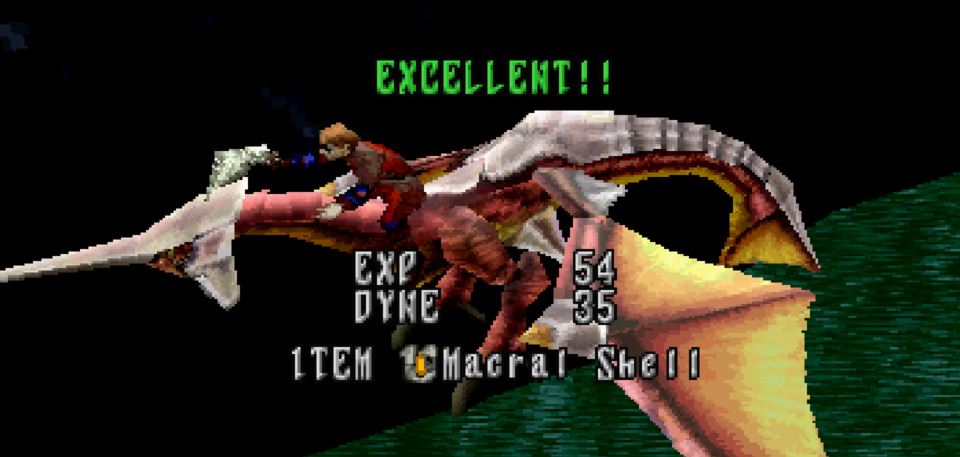
Nevertheless, there's nothing quite as effective as Midgar in Final Fantasy VII, and Panzer Dragoon Saga has no proper response or clap-back to Alexandria's dynamism in Final Fantasy IX. Team Andromeda set its sights on one-upping Squaresoft in the realm of gameplay and artistic ambition. And you know what? They met that goal. Still, being a team that barely cared about writing and worldbuilding from its inception, even at the peaks of Panzer Dragoon and Zwei, Team Andromeda missed the call regarding the RPG trend towards epic stories and dramatic characterization. On the flip side, there is a positive here: Panzer Dragoon Saga clocks in at around twenty hours and is even shorter if you avoid its side quest trappings and stay on its main path entirely. While there are some fun character-based interactions to be had, this route is probably the one I recommend. You want to run through this game quickly to enjoy the textures and kaleidoscope of 3D environments it has to share. I forgot to mention this point earlier, but the 3D-dominant processor in the Saturn had an unusual feature wherein it could take any texture and stretch it infinitely. The environments where you are hovering over oceans and large bodies of water are incredible because they stretch out into eternity, which adds to the game's themes of being isolated or far from civilization.
Edge is a fine protagonist; the person who voiced him also did an admirable job. There is a weird moment when the game suddenly transitions from using the fake in-universe "Panzerese" language the previous two games used to Japanese. Still, the inflections and intonations avoid anime dramatics I sometimes abhor, at least for the most part. The odd thing to note is that Team Andromeda did play Final Fantasy VII and the works of others and indicated that they wanted to avoid a spiky-haired anime trope like Cloud while avoiding a silent protagonist as well. With Edge, you end up with a JRPG with a remarkably "normal" character. Edge is a mercenary who wants revenge against someone who killed his father figure, and upon being chosen by a dragon to be their companion, he initially views their steed as a means to get to his end goal. However, he comes to warm up to the dragon over time, and the game does a neat thing where it manifests this budding relationship by having the dragon play with Edge whenever you use a camp to rest. It was refreshing to have a JRPG protagonist who almost entirely avoided big dramatic anime soliloquies or didn't get grafted to a ham-fisted romance angle. Edge is just a guy and remains so from the game's start to finish. That said, if you like ensemble casts with character arcs that convey personal growth, you must temper your expectations. Edge is one of maybe six characters the game gives more than seven minutes of speaking time.
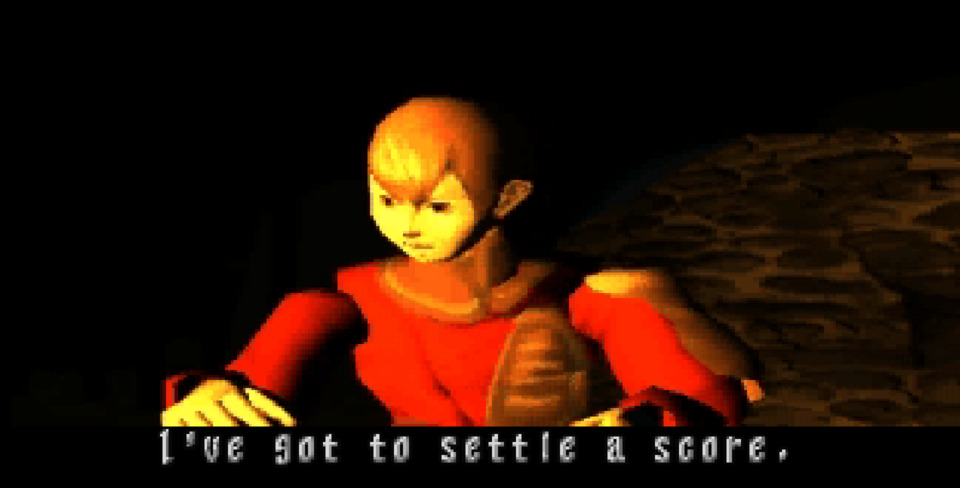
The awe-inspiring set pieces and encounter designs carry Panzer Dragoon Saga, especially when you butt against some of its design quibbles. While Team Andromeda deserves reasonable credit for making 3D world exploration fun in the context of a roleplaying game and modifying the traditional menu-based combat of typical JRPGs to be more authentic, they only solved some qualms with the genre and, in some areas, came up short. Firstly, there are only a handful of side quests in the game, and I can count the number of times you should go back to explore previous environments on a single hand. But more distressingly, when the game repeats certain RPG hallmarks, it does so, not knowing how awkward and out of place they feel. By the third disc, many dungeons remove your sense of scale, force you down narrow corridors, and feature no exploration. There's even a level where you temporarily lose the ability to ride the dragon, and it is one of the worst levels in the game because its enemy battles take forever, and you don't get anything out of the combat because it doesn't net experience points. I do not want my following claim to come off as shameless apologism. Still, it's not like the PS1 Dragon Quest and Final Fantasy games were not free from similar mid-game slogs that ran antithetical to epic introductions or climaxes. Final Fantasy VII's Temple of the Ancients is an absolute low point with its Byzantine optical illusion-level design. Final Fantasy VIII's D-District Prison and IX's Oeilvert sequences are also total pains in the ass.
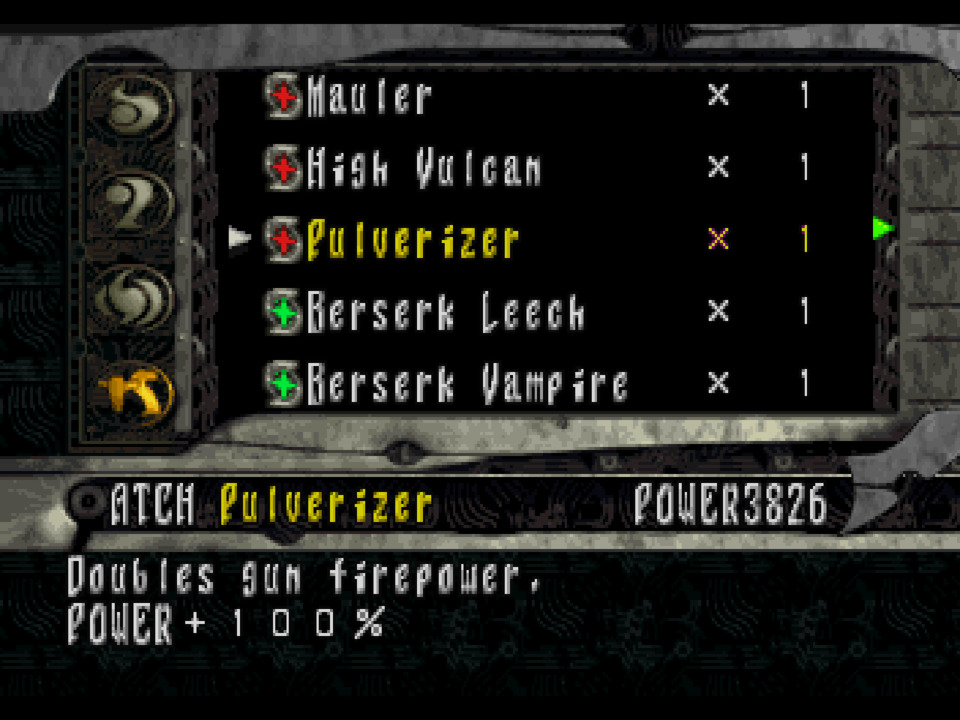
Nonetheless, there does come the point where the game feels like it runs out of ideas. By the tail-end of the third disc, I found dropping an endless supply of AOE spells would off practically everything the game presented to me short of bosses. The balance with the game's leveling also reeks of a team not accustomed to making an RPG, as your MP pool will likely max out before the third disc's end. The in-game economy is also out of whack in that there are only a few things to buy and equip onto Edge or their dragon, which results in at least three-quarters of your in-game purchases being healing items, which the game also gives you fairly regularly. I only died four times during my blind playthrough, which is my way of saying that this game is piss easy outside of a few set pieces, but that might be an asset to those that hate punishing JRPG boss design. Even the epic final boss in this game feels immediately "doable." But the one thing that might frustrate some that end up giving this game a shot is that after presenting its novel combat system, most of its bosses and late-game encounters boil down to"Oh, hey, good job in nailing the correct pattern. Now do that twenty more times." A handful of environments are oriented around status effects, which are more debilitating than usual, considering you only have three possible combat options, and losing even one of those is crushing.
The Ending Of The Game Is INCREDIBLE! (This Is The Only Section With Story Spoilers)
I spent a good portion of the previous section talking about the "normalcy" of Panzer Dragoon Saga's protagonist as a point of praise and a word of caution. I used the word "practically" in the title of this blog for a reason when comparing Saga to Final Fantasy VII and IX or Dragon Quest VII. There are indeed "epic" moments in Saga, such as when the proverbial evil empire levels your starting hub world, which leaves you scrambling to find alternative sources of equipment and materials. That's an incredible moment, but when the game only has two cities, and what it accomplishes with them is about as by the numbers as you can get in an RPG, you can't help but feel like the game is missing something at times. Likewise, Team Andromeda approached their first JRPG with a sense of wanting to do things differently from the norm, but they were still guilty of copying Square and Enix's homework in their game. The final two levels of the game provide the expected point of no return and boss rush but with several mechanical complications that end up muddying the waters.
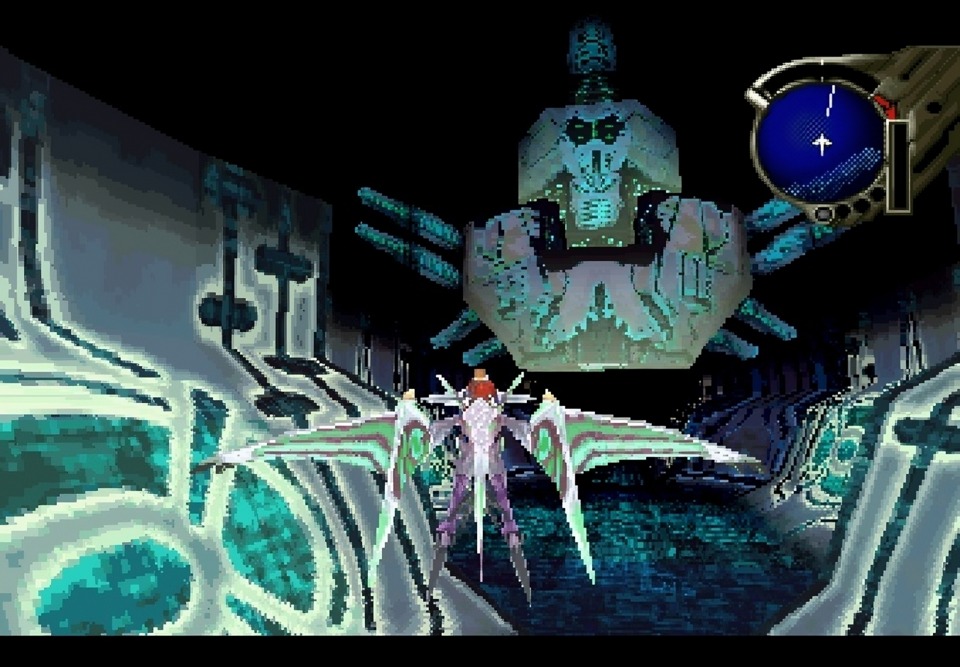
The final dungeon in Panzer Dragoon Saga is not good. While studying Final Fantasy and Dragon Quest, Team Andromeda must have noticed that the last dungeons in RPGs tend to put players through the rigors of needing to tie all of their respective game's mechanics together before getting to the finish line. Their notion of mixing things up includes putting in 3D teleport mazes and laser grids that instantly trigger security alarms and spawn waves of random encounters if you are not careful. On top of that, the dungeon is built vertically rather than horizontally, which leads to you needing to struggle with the game's lousy draw distance and FOV. Worse, the level is a repeat of one you have explored prior. I should have mentioned this earlier, but when Team Andromeda wanted to be done with Saga after years of misery, they decided to recycle levels from previous Panzer Dragoon games and ones you have already tackled in Saga. And if you attempt to get the "secret" ultimate dragon form, you need to stomach even more backtracking for odd trinkets and obscure lever puzzles that are impossible to find and solve if you are not following a guide.
And yet, there is one example of Team Andromeda lifting from the works of Squaresoft to its benefit in Panzer Dragoon Saga. After you attempt and fail to stop an evil emperor from unlocking a portal to an alternate dimension, said villain ends up offing himself after he unwittingly unleashes a wave of uncontrollable monsters on the world. The person Edge has been chasing after as part of their revenge campaign reveals that he was trying to prevent this exact outcome from happening. He has a sudden mini-redemption arc as he expires in Edge's clutches. Also, if you Google Panzer Dragoon Saga, you might come across a female android with a skeletal and monochromatic look. She's named Azel and is the key to stopping the horrible monsters from wrecking the world of Panzer Dragoon Saga. After Edge hooks her up to a mechanical device, she unlocks a portal to a dimension called "Sestren," which turns out to be a neural-based worldwide web. Yeah, the internet is EVIL in this game! Likewise, as Edge explores the internet, he comes across a legendary dragon who calls Edge a pretender and says that the actual "hero of legend" is watching Edge's actions right now. That's right, this game breaks the fourth wall and reveals that you and I are the heroes the Panzer Dragoon Saturn trilogy has been waiting for all along. Team Andromeda must have played some of Squaresoft's Final Fantasy games, and their most significant takeaway from them, narratively speaking, is that they needed a big plot twist that came out of nowhere. But here's the thing: they take this twist to such an extreme it's downright magical. For example, when the legendary dragon drops this whopper on you, he says that the "true hero" must "push a button to show they are there," in response, the game cuts to black and stays that way until you hit a controller input. Then, as Edge walks into a portal, he turns to the camera and thanks you for your hard work as he dematerializes as the world of Panzer Dragoon Saga no longer needs him; it needs YOU!
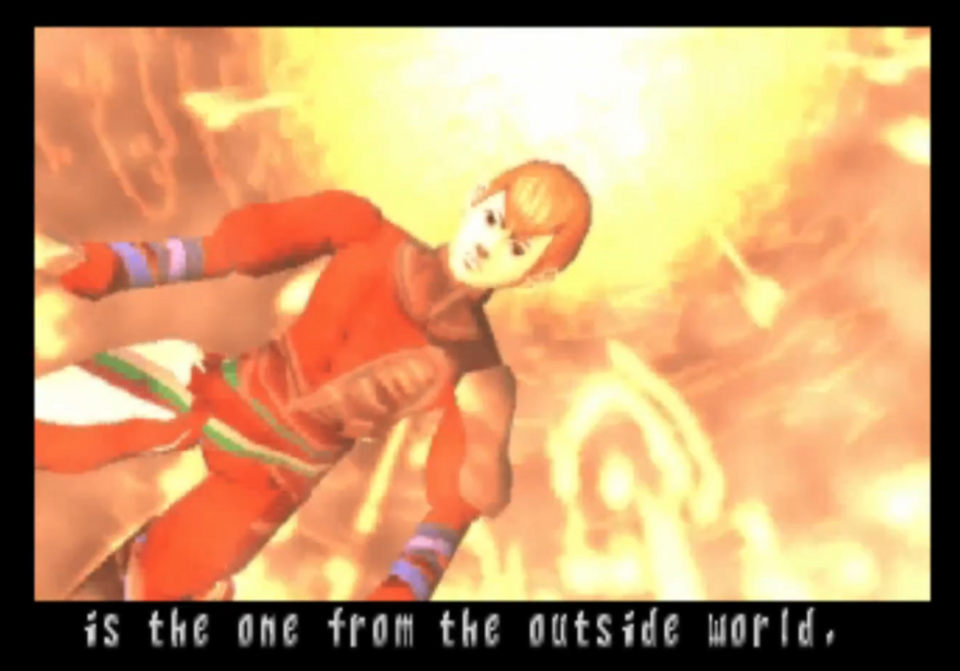
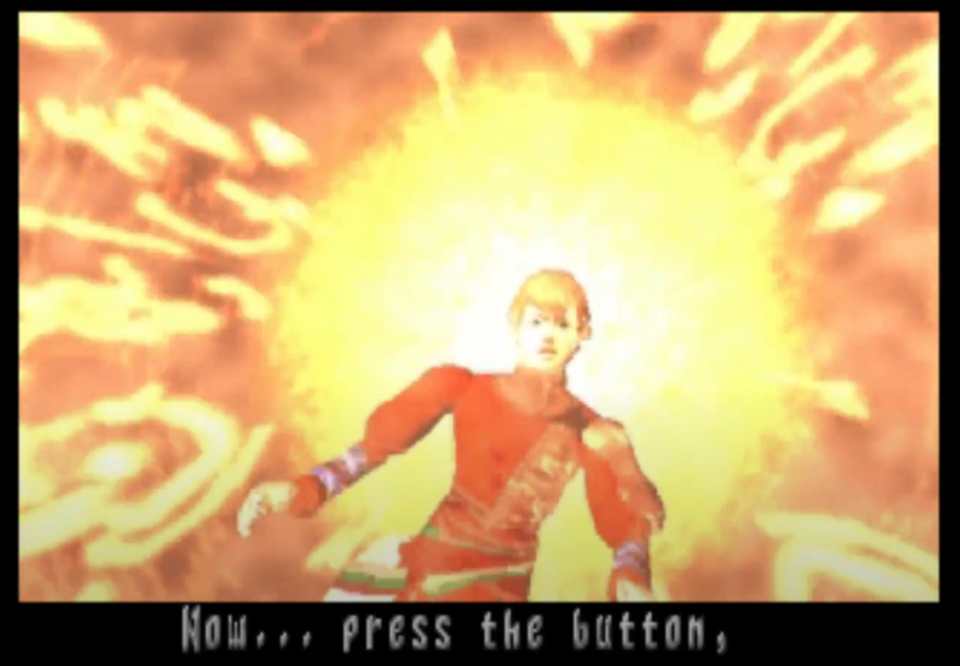
The ending of Panzer Dragoon Saga is a rushed mess. One sign of that is that the game's credits are in Japanese and entirely untranslated. If you read that piece by The Ringer I linked to earlier, you'll learn that only two people translated the game, and their experience was as miserable as those who made it. One contracted a lung disease midway into the game's localization and continued working, fearing losing their job, while coughing blood in a hospital bed. On top of that, Sega never provided them with a complete script, and they had to translate the game while playing it. Both translators also took an approach to localization that errs towards the methods of Working Designs (i.e., they translated things incredibly liberally). There's a reference to John Woo when you examine an ornamental gun in a hunter's shack and a South Park reference in one of the bars in the first city. More controversially, the localization team decided to have Azel's final words to Edge be "I love you." While I am by no means fluent in Japanese, that is NOT what she says in her audio or script. The franchise has seemingly decided to live with that recontextualization with the release of Panzer Dragoon Orta. For those who have played Orta, you know that Azel is the mother of the game's protagonist, and there's an audio log where she admits to failing to find Edge, though the meaning of which is left ambiguous.
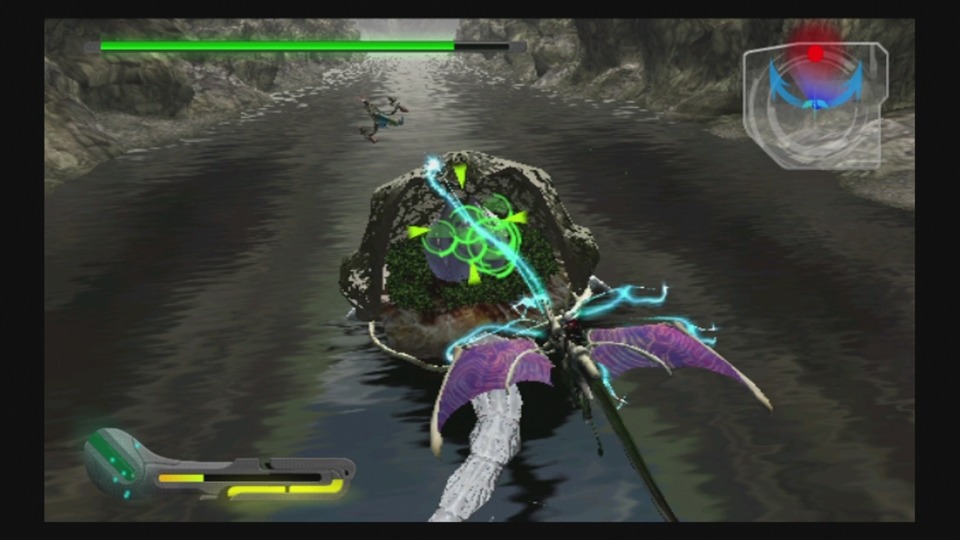
Me mentioning Orta in proximity to the conclusion of Saga leads me to a fun but wild tangent I cannot avoid talking about here. First, you should know that some Panzer Dragoon purists out there do not view Orta as being "canon," as it was not developed by the core members who started the series. They also claim that certain portions of Orta's story seemingly conflict with moments from the Saturn trilogy. I will come forward and say I think these people are crazy. Imagine, if you could humor me for a moment, people on the internet claiming BioShock 2 wasn't canon because Ken Levine didn't direct it or that any post-9 Final Fantasy games weren't "true" entries in the series because they lacked Sakaguchi. It's pure bananas, but that's not even the wildest theory these Panzer Dragoon fanatics, whom I love, put forth. While I do not entirely understand where this started, Panzer Dragoon Saga has its version of the "Squall is Dead" fan theory. The theory for Saga posits that when the game prompts you to click a button, the correct answer is to walk away from the game and not do anything. The reasoning is that when you do as the legendary dragon requests, there's a cataclysmic event that destroys the series of towers that serve as the world's source of technology. By complying with the dragon's words, you are enacting the game's "bad ending." It's a water cooler head cannon that would have deserved a second gander had this game not shipped 20,000 units in North America. Still, if anything, it serves as a reminder of how "thirsty" fans of the series are for another game that follows in Saga's footsteps and addresses its MANY loose ends.
Don't Pay $1,000 For This Game! (i.e., Sega Should Do More With Its Saturn Catalog)
I pose this question that famed Gaint Bomb essayist Borgmaster once posed to me while I was playing Panzer Dragoon Saga. Is there any other video game franchise that achieved less than the Panzer Dragoon series while being as consistently good as the Panzer Dragoon games? There is no terrible Panzer Dragoon game, yet no one ever talks about it as an all-time franchise or series. Part of this stems from Sega's continual disservice it does with its catalog of games on the Saturn outside of a few exceptions. With its utterly messed up launch, Panzer Dragoon Saga never got the proper release it deserves, and several people and companies have had to pay the price for that. Futatsugi has an underrated legacy in the games industry, with their most remarkable work primarily underappreciated by most video game editorialists and historians because of Saga's limited printing and availability. His tenure with Microsoft, wherein he was the Xbox's point guy in Japan, is where more people will likely recall his name. Magatama and Phantom Dust were all early Japan-made OG Xbox projects that he had a hand in and spearheaded. Blue Dragon and Lost Odyssey were also game projects he managed. He's still kicking around in the game scene, having helped Swery manage The Good Life and founded his own studio, Grounding Inc., which the board gaming community knows as the source of Machi Koro. Yeah, the people who made Panzer Dragoon went on to make one of the most well-known and ubiquitous modern board games.
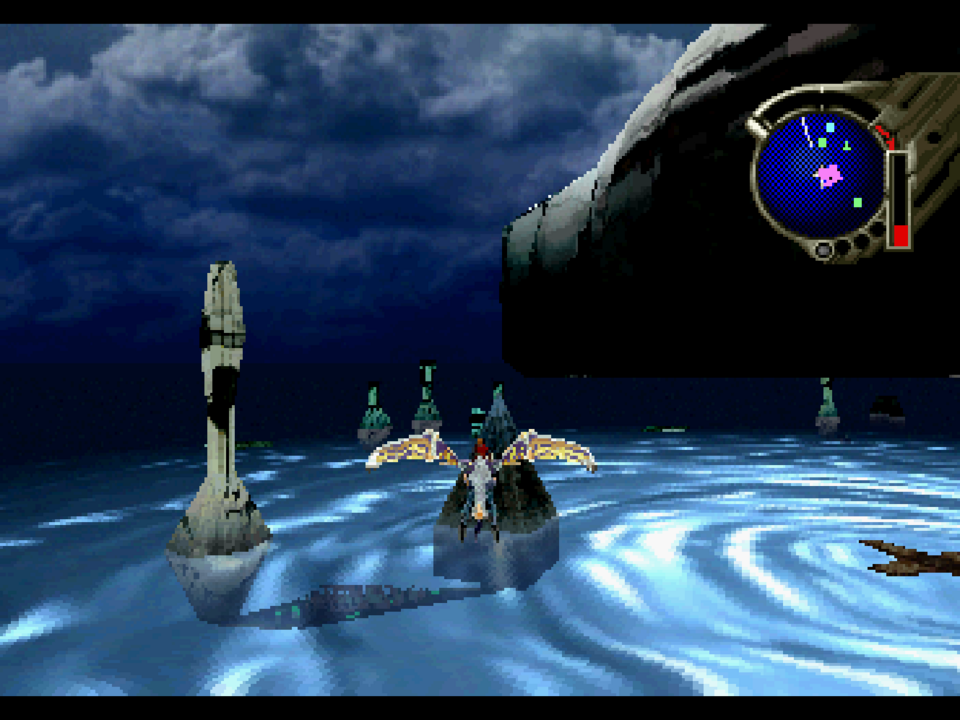
Boiling the sometimes overwhelming menu-based systems of Dragon Quest or Final Fantasy into a bite-sized chunk was an admirable endeavor that feels authentic and entirely warranted in Panzer Dragoon Saga. The game starts with a ten-minute FMV CG cutscene that definitively initiated Team Andromeda's nearly twenty-hour treaty on why they thought they should have been spoken in the same breath as other titans in the JRPG market. It was wedged between Final Fantasy VII and VIII, and I dare you to tell me that Panzer Dragoon Saga doesn't look better than either at times. Having a morphing 3D dragon be something your player can engage with at the drop of a hat was a power move and another example of Team Andromeda wanting to strut in a crowded field. Scoring the player's performance during battles and bosses and encouraging them to lean into the game's value in speed results in a JRPG that feels immediately manageable for all player types. Short of Vagrant Story, which relies on 2D sprites and shading trickery more than Panzer Dragoon Saga, the technical prowess of Saga is one of the best across an entire generation of console games.
When I look at the normalization of Shenmue fans and their almost fetishistic relationship with their game obsession with the advent and rise of the Yakuza games, I come to another disappointing realization. While the ideas of Shenmue would go on to become more or less fully realized with the Yakuza series, the exciting experiments in Panzer Dragoon Saga have yet to be similarly refined in subsequent RPGs in Japan or worldwide. No game employs Saga's fast-paced positional-based combat system because rail shooters are essentially a forgotten genre in the medium of games. No game scratches the same itch as Saga, and few games have comparably challenged the hardware they were designed to use like it as well. Considering the trials and tribulations of the development team, it is understandable that no person or team is willing to subject itself to what Team Andomeda had to endure to make Panzer Dragoon Saga. Yet, with this game being one with a reputation that holds it to be an all-time experience, and in my opinion, that reputation is well-earned, it is downright immoral that Sega has done nothing with it since its heartbreaking limited release.
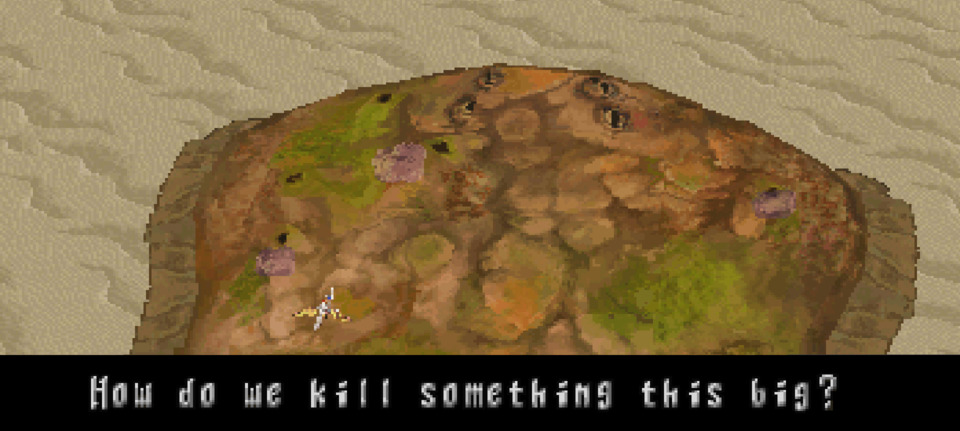
As the price for loose copies ticks upwards, thanks to expanding prices in the retro gaming scene, the time and place for a remaster or port of Saga continues to be "as soon as possible." Sega is familiar with treating their classic catalog of games with the respect they deserve. Their Mega Drive and Genesis Classics program continues to be an incredible deal, even after they delisted the Sonic games to re-release them as part of a separate package. Yet again, this frustration points to a disappointing unwillingness by Sega to look at the Saturn and bring its gems and notable titles to the forefront. With them having recently signed off on Monster Boy and the Cursed Kingdom and Alex Kidd in Miracle World DX, you can even claim that they treat the Master System with more respect than the Saturn, even if not a single title on the Master System reaches the meteoric heights of Panzer Dragoon Saga. It's a shame. With Sea of Stars and other indie titles taking the RPG scene by storm, there is a growing appetite for Saga's up-tempo pace, manageable difficulty, and comfortable playtime.
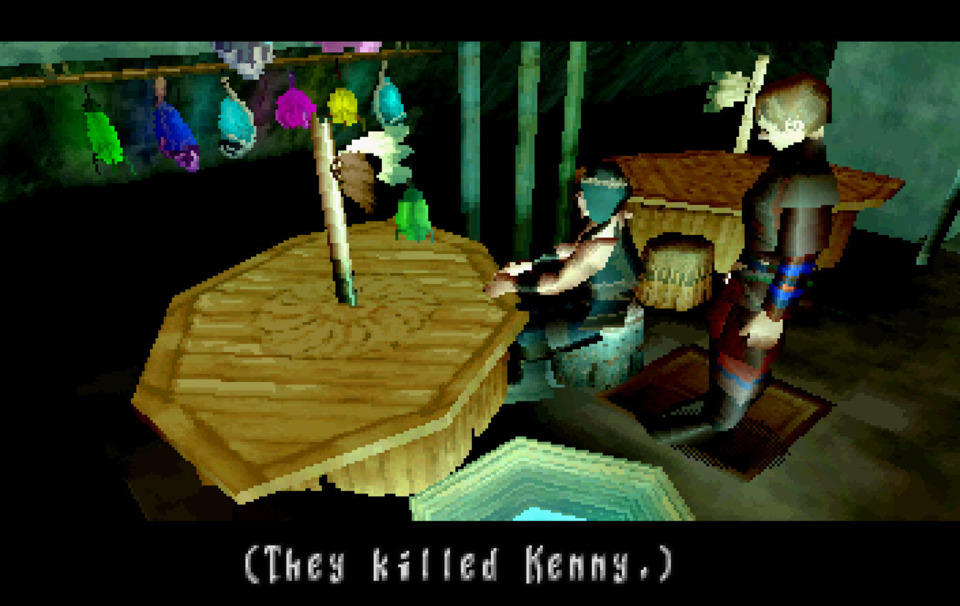
So, if you want to play this game, and I think you should, all I can say is "Go with God." Sega has hinted that they viewed the remaster of the original Panzer Dragoon as a "success" but have experienced development difficulties with their remaster of Zwei. Somewhat frustratingly, while affirming the Zwei remaster is still upcoming, its creative director has hinted that they would be willing to tackle Saga next, but only if the Zwei remaster sells well. This blackmail act is not new to fans of Sega as they did the same thing when they announced Virtua Fighter 5 Ultimate Showdown, an enhanced remaster of Virtua Fighter 5 Final Showdown with rollback netcode. When the team in charge of Ultimate Showdown was pressed on the possibility of a sixth game in the series, its project lead said it would only be possible if Ultimate Showdown sold well—the radio silence in the years since speaks for itself. I avoid claiming that any studio or developer owes its fans or audience anything. Still, for the sake of game preservation and, understanding the legacy of a long-forgotten development team and director and putting more respect to a misunderstood console, I believe Sega owes people a modern re-release of Panzer Dragoon Saga. And Sega stands to benefit as doing so will harken back to when they had a unifying identity of always wanting to be at the forefront of conversations in the industry. Budgets and development time be damned.
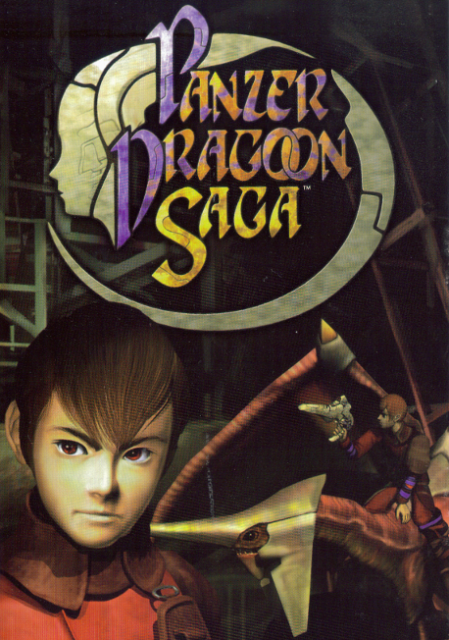
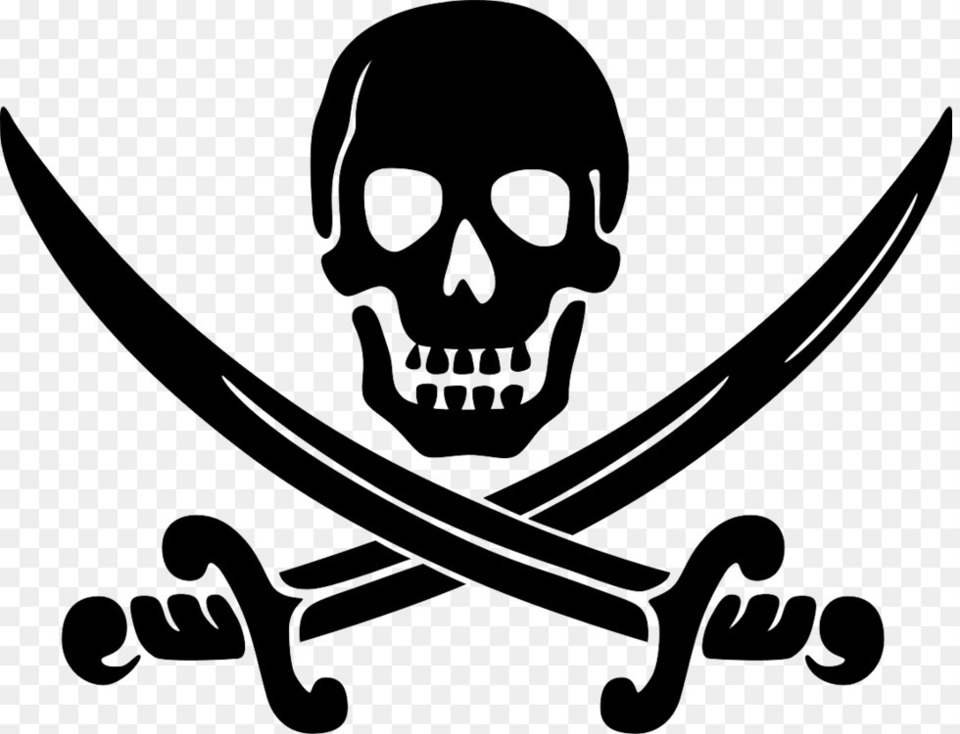
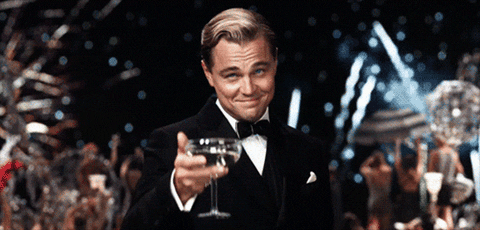
Log in to comment